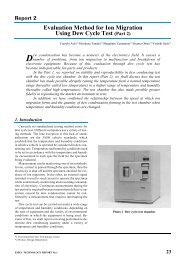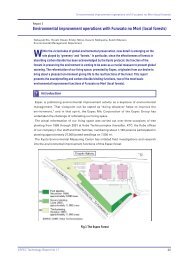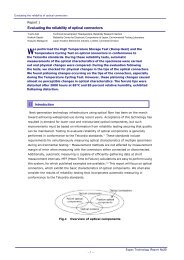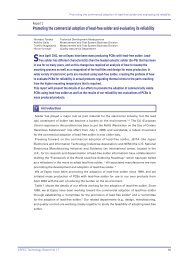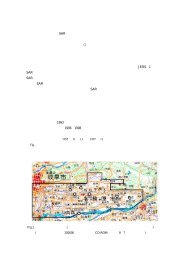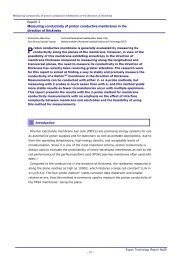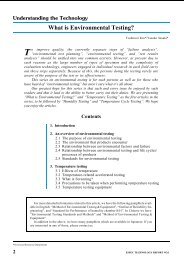download
download
download
Create successful ePaper yourself
Turn your PDF publications into a flip-book with our unique Google optimized e-Paper software.
Measuring Conductivity of Proton Conductive Membrane in the direction of thickness, partⅡ:<br />
using the 4-probe method in the direction of thickness<br />
As mentioned in the connections and equivalent circuit of MEA specimen while measuring by the<br />
membrane thickness 4-probe method in Fig.3, the Potentiostat/Galvanostat was used to apply<br />
AC potential perturbation to the terminals of CE and WE while simultaneously sampling the<br />
electric potential signals between the terminals of RE1 and RE2. When error messages of RE1 O/L<br />
and/or RE1-RE2 O/L occur, they indicate that a higher voltage drop than the 14.5 V limit of the<br />
device has developed between the terminals of RE1 and the ground and/or the terminals of RE1<br />
and RE2. An important phenomenon found while measuring is that the error messages RE1 O/L<br />
and RE1-RE2 O/L occurred simultaneously during the measuring period with a frequency range<br />
lower than 10 kHz. With the WE terminal as the ground for the instrument as shown in Fig.3, it<br />
can only be concluded that the impedance between the terminals of RE1 and RE2 rather than that<br />
between RE2 and WE was overloaded. This may have come from excessive interface resistance<br />
or insufficient interface capacitance (or both) for reference electrodes RE1 and RE2, as shown in<br />
Fig.3. Excessive interface resistance RctRE1 or RctRE2 is thought to have come from poor contact<br />
between the test membrane and reference electrode RE1 or RE2, or disconnected electrode<br />
wires. The following causes of failure can be expected: the snapping-off of electrode wires, the<br />
shielding of electrode terminals by the insulated coating tube or its fragments that may come<br />
from the stretching forward and/or the breaking up of the coating layer of the electrode wire, and<br />
unstable contact between the reference electrode and the test membrane.<br />
4<br />
Observations and discussion for measuring<br />
4-1 Effect of manufacturing conditions of MEA specimens<br />
Effects of hot-pressing conditions and reference electrode materials on MEA measuring<br />
performance are listed in Table 2 for measurements of proton conductivity of Nafion117 ®<br />
membrane using the 4-probe method in the direction of thickness using the AC impedance<br />
technique.<br />
- 9 -<br />
Espec Technology Report No.23



